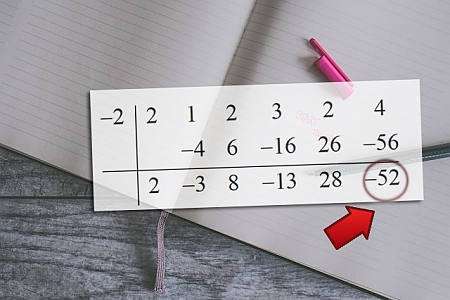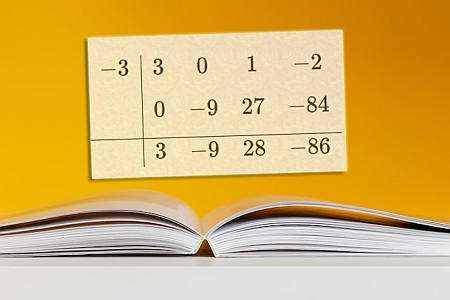Synthetic Substitution
Instructions: Use this synthetic substitution calculator, that shows all the steps of the calculation. Please type in a polynomial P(x) and a value x where you want to evaluate the polynomial in the form below.
Synthetic Substitution Calculator
This calculator can help you with the process of evaluating a polynomial \(p(x)\) at a given point \(x = a\). In order for the calculator to run, you need to provide a valid polynomial of any order, and a valid numeric expression.
For example, you may want to evaluate a point at the polynomial x^5 + 10x^3 - 2x - 12, and the point you want to evaluate is 1/3.
The polynomial does not have to be simplified, as long as it is a valid polynomial. For example, you can type x^5 + 10x^3 - 2x - x + 3 - 1/3 and the calculator will first simplify the polynomial, before conducting the synthetic substitution.
Once you have provided a valid polynomial and a numeric expression, you can click on "Calculate", to get the steps of the process shown, which consists of applying suitable synthetic division. .

Why using Synthetic Substitution?
Synthetic substitution is simply a way of evaluating a value on a given polynomial. This is, you have a value \(x = a\), and a polynomial \(p(x)\), and you want to evaluate the polynomial at the given value, so you want to get the value of \(p(a)\).
Now, the question is why not simply plugging in the value of x = a into p(x)? For example, with the polynomial \(p(x) = x^5 + 10x^3 - 2x - 12\) and the value \(x = \displaystyle \frac{1}{3}\) we would need to compute
\[\displaystyle p\left(\frac{1}{3}\right) = \displaystyle \left(\frac{1}{3}\right)^5 + 10\cdot \left(\frac{1}{3}\right)^3 - 2\cdot \left(\frac{1}{3}\right) - 12 \]Although doable, the above calculation feels like, hmmmmm, not to inviting to say the least. So then, is there a better, easier way to evaluate \(x = \displaystyle \frac{1}{3}\) through the polynomial \(p(x) = x^5 + 10x^3 - 2x - 12\)?? You bet there is?
It turns out that, by virtue of the remainder theorem, when you have a polynomial \(p(x)\), and you divide it by \(x-a\), then then remainder of it is equal to \(p(a)\).
Magic, right? So then all you need to do is to take the polynomial \(p(x)\), and do a polynomial division with \(x-a\) using synthetic division (you can use long division too, but it is a bit more cumbersome)
Steps for using Synthetic Substitution
- Step 1: Identify the polynomial p(x) you are working with, and the value x = a you want to evaluate the polynomial at
- Step 2: If the degree of the polynomial is zero, then the polynomial is constant and p(a) is that constant too
- Step 3: Assume the polynomial has degree 1 or above. Apply synthetic division to the dividend p(x) and divisor x - a
- Step 4: Once you are done, look at the last column, and you will find the numeric remainder. You will have then that p(a) is equal to that value
So the, we can see that evaluating a polynomial is intimately related with polynomial division, and that is exactly what the Remainder Theorem states.
Applications of Synthetic substitution
As we mentioned before, it is clear that we can use a calculator to explicitly compute \(\displaystyle \left(\frac{1}{3}\right)^5 + 10\cdot \left(\frac{1}{3}\right)^3 - 2\cdot \left(\frac{1}{3}\right) - 12\), but it is obviously computationally expensive.
In Engineering and other applications, it is clear that we will want to use as efficient as possible process, and the process of synthetic substitution gets reduced to a handful of simple multiplications and additions, which are much "cheaper" than the exponentiations that would be required otherwise
How to know when to use synthetic evaluation or simply plug into the polynomial?
- Step 1: Determine the polynomial p(x) you are working with, and the value of x = a, at which you wish to evaluate the polynomial
- Step 2: Look at the degree of p(x), for degrees of 0 or 1, you will simplify plug in the value
- Step 3: For degrees of 2 and beyond, it is more convenient to use synthetic evaluation
The convenience of using synthetic substitution becomes clear as the degree of the polynomial increases, especially for degree 4 and higher..
Tips for Success
Try to following a systematic approach, using the usual tabular method in order to master it. Avoiding mistakes with signs and when you add the rows is crucial to arrive at the final remainder without errors.

Example: Use synthetic substitution
Consider the polynomial : \(p(x) = x^5 + 10x^3 - 2x - 12\), evaluate it at the point \(x = \frac{1}{3}\)
Solution: The following polynomial has been provided: \(\displaystyle p(x) = x^5+10x^3-2x-12\), which needs to be evaluated at the point \(\displaystyle x = \frac{1}{3}\) using synthetic substitution.
In order to conduct the synthetic substitution, we need to do a synthetic division of : \(\displaystyle p(x) = x^5+10x^3-2x-12\), and the divisor \(\displaystyle s = x-\frac{1}{3}\), and find the remainder.
Observe that the degree of the dividend is \(\displaystyle deg(p) = 5\), whereas the degree of the divisor is \(\displaystyle deg(s)) = 1\).
Step 1: Since the divisor has a degree 1, we can use the Synthetic Division method. By solving \(\displaystyle s(x) = x-\frac{1}{3} = 0\) we find directly that the number to put in the division box is: \(\displaystyle \frac{1}{3}\).
\[\begin{array}{c|ccccc} \frac{1}{3} & 1 & 0 & 10 & 0 & -2 & -12 \\[0.6em] & & & & & & & \\[0.6em] \hline & & & & & & & \end{array}\]Step 2: Now we pass directly the leading term \(1\) to the result row:
\[\begin{array}{c|ccccc} \frac{1}{3} & 1 & 0 & 10 & 0 & -2 & -12 \\[0.6em] & & & & & & & \\[0.6em] \hline &1&&&&& \end{array}\]Step 3: Multiplying the term in the division box by the result in column 1, we get: \(\frac{1}{3} \cdot \left(1\right) = \frac{1}{3}\) and this result is inserted in the result row, column 1.
\[\begin{array}{c|ccccc}\frac{1}{3} & 1 & 0 & 10 & 0 & -2 & -12\\[0.6em]& 0 & \frac{1}{3} & & & \\[0.6em]\hline&1&&&&&\end{array}\]Step 4: Now adding the values in column 2, we get: \( 0+\frac{1}{3} = \frac{1}{3}\) and this result is inserted in the result row, column 2.
\[\begin{array}{c|ccccc}\frac{1}{3} & 1 & 0 & 10 & 0 & -2 & -12\\[0.6em]& 0 & \frac{1}{3} & & & \\[0.6em]\hline& 1 & \frac{1}{3} & & & \end{array}\]Step 5: Multiplying the term in the division box by the result in column 2, we get: \(\frac{1}{3} \cdot \left(\frac{1}{3}\right) = \frac{1}{9}\) and this result is inserted in the result row, column 2.
\[\begin{array}{c|ccccc}\frac{1}{3} & 1 & 0 & 10 & 0 & -2 & -12\\[0.6em]& 0 & \frac{1}{3} & \frac{1}{9} & & \\[0.6em]\hline& 1 & \frac{1}{3} & & & \end{array}\]Step 6: Now adding the values in column 3, we get: \( 10+\frac{1}{9} = \frac{91}{9}\) and this result is inserted in the result row, column 3.
\[\begin{array}{c|ccccc}\frac{1}{3} & 1 & 0 & 10 & 0 & -2 & -12\\[0.6em]& 0 & \frac{1}{3} & \frac{1}{9} & & \\[0.6em]\hline& 1 & \frac{1}{3} & \frac{91}{9} & & \end{array}\]Step 7: Multiplying the term in the division box by the result in column 3, we get: \(\frac{1}{3} \cdot \left(\frac{91}{9}\right) = \frac{91}{27}\) and this result is inserted in the result row, column 3.
\[\begin{array}{c|ccccc}\frac{1}{3} & 1 & 0 & 10 & 0 & -2 & -12\\[0.6em]& 0 & \frac{1}{3} & \frac{1}{9} & \frac{91}{27} & \\[0.6em]\hline& 1 & \frac{1}{3} & \frac{91}{9} & & \end{array}\]Step 8: Now adding the values in column 4, we get: \( 0+\frac{91}{27} = \frac{91}{27}\) and this result is inserted in the result row, column 4.
\[\begin{array}{c|ccccc}\frac{1}{3} & 1 & 0 & 10 & 0 & -2 & -12\\[0.6em]& 0 & \frac{1}{3} & \frac{1}{9} & \frac{91}{27} & \\[0.6em]\hline& 1 & \frac{1}{3} & \frac{91}{9} & \frac{91}{27} & \end{array}\]Step 9: Multiplying the term in the division box by the result in column 4, we get: \(\frac{1}{3} \cdot \left(\frac{91}{27}\right) = \frac{91}{81}\) and this result is inserted in the result row, column 4.
\[\begin{array}{c|ccccc}\frac{1}{3} & 1 & 0 & 10 & 0 & -2 & -12\\[0.6em]& 0 & \frac{1}{3} & \frac{1}{9} & \frac{91}{27} & \frac{91}{81}\\[0.6em]\hline& 1 & \frac{1}{3} & \frac{91}{9} & \frac{91}{27} & \end{array}\]Step 10: Now adding the values in column 5, we get: \( -2+\frac{91}{81} = -\frac{71}{81}\) and this result is inserted in the result row, column 5.
\[\begin{array}{c|ccccc}\frac{1}{3} & 1 & 0 & 10 & 0 & -2 & -12\\[0.6em]& 0 & \frac{1}{3} & \frac{1}{9} & \frac{91}{27} & \frac{91}{81}\\[0.6em]\hline& 1 & \frac{1}{3} & \frac{91}{9} & \frac{91}{27} & -\frac{71}{81}\end{array}\]Step 11: Multiplying the term in the division box by the result in column 5, we get: \(\frac{1}{3} \cdot \left(-\frac{71}{81}\right) = -\frac{71}{243}\) and this result is inserted in the result row, column 5.
\[\begin{array}{c|ccccc}\frac{1}{3} & 1 & 0 & 10 & 0 & -2 & -12\\[0.6em]& 0 & \frac{1}{3} & \frac{1}{9} & \frac{91}{27} & \frac{91}{81} & -\frac{71}{243}\\[0.6em]\hline& 1 & \frac{1}{3} & \frac{91}{9} & \frac{91}{27} & -\frac{71}{81}\end{array}\]Step 12: Now adding the values in column 6, we get: \( -12-\frac{71}{243} = -\frac{2987}{243}\) and this result is inserted in the result row, column 6.
\[\begin{array}{c|ccccc}\frac{1}{3} & 1 & 0 & 10 & 0 & -2 & -12\\[0.6em]& 0 & \frac{1}{3} & \frac{1}{9} & \frac{91}{27} & \frac{91}{81} & -\frac{71}{243}\\[0.6em]\hline& 1 & \frac{1}{3} & \frac{91}{9} & \frac{91}{27} & -\frac{71}{81} & -\frac{2987}{243}\end{array}\]which concludes this calculation, since we have arrived to the result in the final column, which contains the remainder.
Conclusion: Therefore, we conclude that for the given dividend \(\displaystyle p(x) = x^5+10x^3-2x-12\) and divisor \(\displaystyle s(x) = x-\frac{1}{3}\), we get that the remainder is \(\displaystyle r(x) = -\frac{2987}{243}\), so then we conclude that \(\displaystyle p\left(\frac{1}{3}\right) = -\frac{2987}{243}\).
Example: Application of synthetic substitution
Is the value x = 1 a root of the polynomial : \(p(x) = x^4 - x^3 + 4x + 3\)?
Solution: Synthetic substituion can be applied like in the previous example, but in the case of a simple value like x = 1, we just can simply plug x = 1 in and the calculation is very simple:
\[p(1) = 1^4 - 1^3 + 4\cdot 1 + 3 = 1 - 1 + 4 + 3 = 7 \ne 0\]so then x = 1 is not a root.
Example: More synthetic substitutions
Evaluate p(1/2) for \(p(x) = x^4 - 2x^3 + 4x + 3\).
Solution: Now we have \(\displaystyle p(x) = x^4-2x^3+4x+3\), to be evaluated at the point \(\displaystyle x = \frac{1}{2}\) using synthetic substitution.
So we use synthetic division of : \(\displaystyle p(x) = x^4-2x^3+4x+3\), and the divisor \(\displaystyle s = x-\frac{1}{2}\), and the objective is to find the remainder.
Step 1: Since the divisor has a degree 1, we can use the Synthetic Division method. By solving \(\displaystyle s(x) = x-\frac{1}{2} = 0\) we find directly that the number to put in the division box is: \(\displaystyle \frac{1}{2}\).
\[\begin{array}{c|cccc} \frac{1}{2} & 1 & -2 & 0 & 4 & 3 \\[0.6em] & & & & & & \\[0.6em] \hline & & & & & & \end{array}\]Step 2: Now we pass directly the leading term \(1\) to the result row:
\[\begin{array}{c|cccc} \frac{1}{2} & 1 & -2 & 0 & 4 & 3 \\[0.6em] & & & & & & \\[0.6em] \hline &1&&&& \end{array}\]Step 3: Multiplying the term in the division box by the result in column 1, we find: \(\frac{1}{2} \cdot \left(1\right) = \frac{1}{2}\) and this result is inserted in the result row, column 1.
\[\begin{array}{c|cccc}\frac{1}{2} & 1 & -2 & 0 & 4 & 3\\[0.6em]& 0 & \frac{1}{2} & & \\[0.6em]\hline&1&&&&\end{array}\]Step 4: Now adding the values in column 2, we find: \( -2+\frac{1}{2} = -\frac{3}{2}\) and this result is inserted in the result row, column 2.
\[\begin{array}{c|cccc}\frac{1}{2} & 1 & -2 & 0 & 4 & 3\\[0.6em]& 0 & \frac{1}{2} & & \\[0.6em]\hline& 1 & -\frac{3}{2} & & \end{array}\]Step 5: Multiplying the term in the division box by the result in column 2, we find: \(\frac{1}{2} \cdot \left(-\frac{3}{2}\right) = -\frac{3}{4}\) and this result is inserted in the result row, column 2.
\[\begin{array}{c|cccc}\frac{1}{2} & 1 & -2 & 0 & 4 & 3\\[0.6em]& 0 & \frac{1}{2} & -\frac{3}{4} & \\[0.6em]\hline& 1 & -\frac{3}{2} & & \end{array}\]Step 6: Now adding the values in column 3, we find: \( 0-\frac{3}{4} = -\frac{3}{4}\) and this result is inserted in the result row, column 3.
\[\begin{array}{c|cccc}\frac{1}{2} & 1 & -2 & 0 & 4 & 3\\[0.6em]& 0 & \frac{1}{2} & -\frac{3}{4} & \\[0.6em]\hline& 1 & -\frac{3}{2} & -\frac{3}{4} & \end{array}\]Step 7: Multiplying the term in the division box by the result in column 3, we find: \(\frac{1}{2} \cdot \left(-\frac{3}{4}\right) = -\frac{3}{8}\) and this result is inserted in the result row, column 3.
\[\begin{array}{c|cccc}\frac{1}{2} & 1 & -2 & 0 & 4 & 3\\[0.6em]& 0 & \frac{1}{2} & -\frac{3}{4} & -\frac{3}{8}\\[0.6em]\hline& 1 & -\frac{3}{2} & -\frac{3}{4} & \end{array}\]Step 8: Now adding the values in column 4, we find: \( 4-\frac{3}{8} = \frac{29}{8}\) and this result is inserted in the result row, column 4.
\[\begin{array}{c|cccc}\frac{1}{2} & 1 & -2 & 0 & 4 & 3\\[0.6em]& 0 & \frac{1}{2} & -\frac{3}{4} & -\frac{3}{8}\\[0.6em]\hline& 1 & -\frac{3}{2} & -\frac{3}{4} & \frac{29}{8}\end{array}\]Step 9: Multiplying the term in the division box by the result in column 4, we find: \(\frac{1}{2} \cdot \left(\frac{29}{8}\right) = \frac{29}{16}\) and this result is inserted in the result row, column 4.
\[\begin{array}{c|cccc}\frac{1}{2} & 1 & -2 & 0 & 4 & 3\\[0.6em]& 0 & \frac{1}{2} & -\frac{3}{4} & -\frac{3}{8} & \frac{29}{16}\\[0.6em]\hline& 1 & -\frac{3}{2} & -\frac{3}{4} & \frac{29}{8}\end{array}\]Step 10: Now adding the values in column 5, we find: \( 3+\frac{29}{16} = \frac{77}{16}\) and this result is inserted in the result row, column 5.
\[\begin{array}{c|cccc}\frac{1}{2} & 1 & -2 & 0 & 4 & 3\\[0.6em]& 0 & \frac{1}{2} & -\frac{3}{4} & -\frac{3}{8} & \frac{29}{16}\\[0.6em]\hline& 1 & -\frac{3}{2} & -\frac{3}{4} & \frac{29}{8} & \frac{77}{16}\end{array}\]Conclusion: Therefore, we conclude that for the given dividend \(\displaystyle p(x) = x^4-2x^3+4x+3\) and divisor \(\displaystyle s(x) = x-\frac{1}{2}\), and we get that the remainder is equal to \(\displaystyle r(x) = \frac{77}{16}\), so then we conclude that \(\displaystyle p\left(\frac{1}{2}\right) = \frac{77}{16}\).
More polynomial calculators
The importance of the polynomial evaluations and calculations cannot be understated. Polynomial roots are incredibly versatile and appear in so many applications in Physics and Engineering. .
In this article we saw the clear connection with synthetic substitution with both synthetic division and long division, which closes the circle that is spanned by the Remainder Theorem, which without a doubt is a direct predecessor to the Fundamental Theorem of Algebra.




